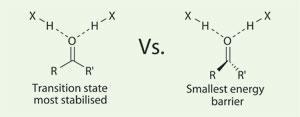The way enzyme catalysts bind molecules to speed up their reactions is not as simple as once thought, say chemists from the UK and Spain
The way enzyme catalysts bind molecules to speed up their reactions is not as simple as once thought, say chemists from the UK and Spain. Enzymes do not necessarily bind in the way that will most stabilise the reaction’s transition state, but rather in a way which minimises the overall energy barrier for the reaction. Applying this idea to the design of new molecular catalysts could help improve their performance.
People often think enzymes catalyse reactions by transition state stabilisation, explains Jonathan Goodman from the University of Cambridge. The transition state can be thought of as the top of an energetic ’hill’ that has to be climbed for the reaction to proceed - if that energy is lowered, the reaction should go faster.
However, what Goodman - together with Luis Sim?n from the University of Salamanca - found when they mined the protein databank (PDB) to look at the way enzymes achieved this, was that the hydrogen-bonding groups in the enzyme active sites were not set up to give maximum stabilisation of the transition state. ’This was very mysterious,’ says Goodman, ’especially since proteins have had millions of years of evolution.’
Oxyanion hole-type enzymes catalyse addition reactions to carbonyl (C=O) groups. Goodman explains that they expected to see the enzyme active sites arranged with hydrogen bond donors in the same plane as the carbonyl, since this is known to give the best stabilisation of the transition state. ’We thought we knew how it worked, because we can look in the Cambridge structural database (CSD) and see how hydrogen bonds interact with carbonyl groups [in small molecule crystals].’

However, what they found looking at the enzyme structures was that the hydrogen bond donors tended to be twisted out of the plane of the carbonyl. ’We did some high level calculations that confirmed that the enzymes were not stabilising the transition state as well as they could be,’ says Goodman, which meant there had to be a different reason for the twisted binding.
The pair found that binding in a planar configuration also lowered the energy of the starting reactant molecule - the ground state of the reaction - and by more than the transition state was lowered. This means that the overall energy barrier - the size of the hill the molecules have to get over - is actually bigger. ’What the enzymes do is not to stabilise the transition state as well as they could, but the key thing is they’re not stabilising the starting material very well at all,’ says Goodman, which means the energy barrier is minimised and the reaction goes faster.
Eric Jacobsen, whose group at Harvard University, US, has developed and studied several small molecule and enzyme-mimicking catalysts, is interested by the findings: ’it’s one of these nice results that makes a lot of sense, which gives you the feeling that it should be right,’ he says.
Goodman adds that their study suggests that we need to think differently about enzyme catalysis, and therefore about small molecule catalysis; and that perhaps new, more effective catalysts could be designed using this principle.
’It’s a really interesting idea and will certainly get people thinking about the geometry of hydrogen bond-donors in catalyst design,’ Jacobsen agrees, but he adds that often synthetic catalysts are designed for selectivity rather than simply to speed up reactions, ’and thinking about how to create the optimal strained hydrogen bonding arrangement for one pathway over another gets really hard, but it’s nonetheless very interesting.’
Phillip Broadwith
References
J. Org. Chem., 2009, DOI:10.1021/jo901503d






No comments yet